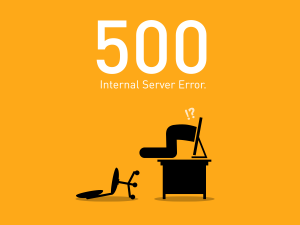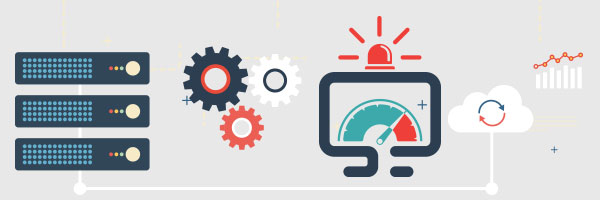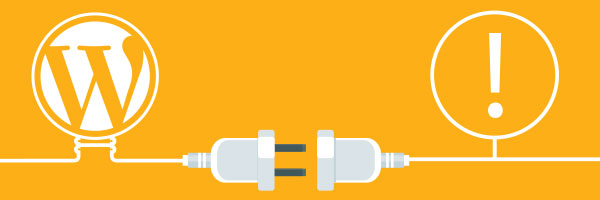4 ways to fix 500 Internal Server Error in WordPress
 You will probably agree that getting a “500 Internal Server Error” message can be quite frustrating.
You will probably agree that getting a “500 Internal Server Error” message can be quite frustrating.
And indeed, it’s one of the ‘worst’ HTTP status codes, as it’s very non-specific.
But there is no need to panic if it happens to you.
Today, we will take a close look at the “500 Internal Server Error” problem and its most probable causes.
We will also show you 4 simple ways to fix the “500 Internal Server Error” in any WordPress site.
What is 500 Internal Server Error?

“500 Internal Server Error” is a type of a ‘catch-all’ error message. It basically translates as “The server is having problems loading this page”.
The exact nature of this problem, however, is unknown. This makes it hard to pinpoint.
Compare this to the “404” error message – upon seeing it, you immediately know the cause of the problem.
On top of everything else, what exactly you will see depends on the type and version of the web server itself. Here is a quick list of the possible messages you can run into:
500 Internal Server Error
HTTP 500 – Internal Server Error
Temporary Error (500)
Internal Server Error
HTTP 500 Internal Error
500 Error
HTTP Error 500
500. That’s an error
And none of them gives any useful clues as to what exactly has happened.
Probable causes for “500 Internal Server Error”

Multiple different problems can cause the “500 Internal Server Error” message to appear on your WordPress-based website.
Here are the ‘usual suspects’:
- problems with the .htaccess file;
- PHP memory exhaustion;
- plugin issues;
- corrupted WordPress core files;
Each one of these problems is fixable and today we will show you how to repair them.
But before we start, a quick word about backups.
You should create a fresh one before you start messing around with the WordPress files.
This way, even if you mess things up, you can quickly restore your content and fix the problem.
Problems with the .htaccess file

A corrupted .htaccess file is very often the reason for the appearance of the irritating “500 Internal Server Error” screen.
You can easily find out whether a given “500 Internal Server Error” issue has been caused by a corrupted .htaccess file.
All you have to do is rename the file itself to .htaccess_test (or something similar).
Then reload your website.
If the “500 Internal Server Error” message is still there, then the problem lies somewhere else.
If it’s gone, then it’s time to take a close look at the .htaccess file in question.
WordPress installations come with a default .htaccess file. So, you can just copy the code for that file and paste it to your own one.
You can find a sample WordPress .htaccess file here.
Another method is to log into your WordPress admin area and to go to the permalink settings (Settings -> Permalinks).
This will automatically recreate the .htaccess file for you.
The PHP memory usage quota has been exceeded

The PHP memory allocation itself may be another reason why the “500 Internal Server Error” message has shown up on your website.
A lot of shared hosting providers limit the amount of RAM resources that PHP processes can take up in order to prevent server overload.
However, most of them do it quite aggressively, setting it to just a few megabytes.
You can fix this with the help of the php.ini file.
Look for it in the root folder for your website (usually it’s /public_html/).
If you don’t see a php.ini file there, contact your web hosting company’s support team.
Once you’ve found it, open it with any text/code editor and look for the following line:
memory_limit =.
Change the value to a higher one, for example:
memory_limit = 300M.
Save the file and wait for a couple of minutes. Then refresh your website.
Remember that solving the PHP memory exhaustion issue is not a permanent cure against the “500 Internal Server Error” screen’s appearance. It’s just a temporary solution. PHP memory exhaustion implies that something on your WordPress-based website is consuming too many server resources.
It is recommended that you run a diagnostic test and analyze your error logs.
Plugin issues

Plugins are often the cause of the problem.
Luckily for us, it’s really simple to determine if they are the culprit.
Simply go to your WordPress installation and look for the /wp-content/plugins/ folder. It should be located inside the wp-content folder.
Once you’ve found it, rename it to something else, for example: /wp-content/plugins_tmp/.
Then, reload your website. If the “500 Internal Server Error” message is gone, then your plugins were indeed the root cause of the problem.
In that case, it’s time for some more troubleshooting procedures.
Revert the renamed folder to its original name and log into the admin area of your WordPress site.
In there, visit the Plugins section and start activating the plugins one by one.
After you have enabled all of them, check if your site is working. Once you’ve pinpointed the one that causes the “500 Internal Server Error” message to show up, you can safely delete it.
However, if the “500 Internal Server Error” message is still on your site even after you have renamed the plugin folder, then the cause of the problem is somewhere else.
Corrupted WordPress Core files

Your core WordPress files can get corrupted too. It happens very rarely, but still, it can happen. And when it does, a “500 Internal Server Error” message can be triggered.
However, even though “corrupted WordPress core” sounds scary, there is a really simple fix for that.
Just visit WordPress.org and download the latest WordPress version.
Here is a direct link to the WordPress CMS download page.
Once you’ve downloaded the .ZIP file, unpack it and look for the wp-admin and wp-includes folders.
You will have to upload them to your WordPress installation and replace your existing files with the new clean ones.
Now check your website – if the reason for the “500 Internal Server Error” message’s appearance was a corrupted core file, the problem should be gone now.
Note: If you are running an older WordPress version, visit the Release Archive and look for the corresponding files.
In Conclusion
More often than not, the annoying “500 Internal Server Error” screen shows up due to a problematic .htaccess file or PHP memory exhaustion.
Whatever the reason may be, it’s pretty easy to take care of this.
So, don’t get nervous and don’t lose your confidence. You can fix this quickly.
This is your first ‘encounter’ with the “500 Internal Server Error” message?
If not, how did you fix the previous issue?
Please do not hesitate to share your comments with us.

Leave a Reply